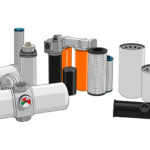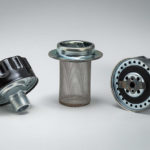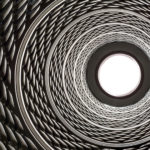By Josh Cosford, Contributing Editor
The venerable return filter is just as crucial to your hydraulic system as your kidneys are to your body. Could your hydraulic system survive with no return line filter? Sure, I suppose in the same way you could survive without kidneys if you strapped on the dialysis machine for five hours a day a few times a week. The hydraulic equivalent to the dialysis machine is the (no pun intended) kidney loop filter, which runs continuously to trap even the finest particles. However, such machines are much more expensive than simple return filters.

Image courtesy of Todd Technologies Inc – TTI
You’ll find that return line filters are the least expensive option, coming in at a fraction of the investment as pressure filters or the aforementioned kidney loop filters (also known as offline filtration). There are return filters for every budget, ranging from spin-on filters actually found on Amazon to premium in-tank units with ultra-fine synthetic elements.
You install return filters in the return line of your hydraulic circuit, appropriately enough. Return filters offer many advantages. First, they offer you the best combination of cost and performance, although I strongly recommend you consider options better than what’s available on Amazon. Spin-on filter assemblies are pretty common, but just as with everything, not all filtration is made equally. You owe your expensive hydraulic machine the filtration quality it deserves, so I recommend only synthetic fiber medium.
Synthetic fibers, such as glass fiber, offer the best combination of low micron filter efficiency, low pressure drop and high dirt holding capacity. In addition, the depth media style elements used in high-efficiency filters trap particles throughout the entirety of the media rather than clog the top surface of the media like inferior paper elements. Unfortunately, only a few manufacturers offer high-quality “absolute” rated spin-on filter assemblies, so shop wisely.
In-tank style filter assemblies provide a convenient mounting location that also avoids messy drips from changing spin-on filter elements. The in-tank assembly drops into a hole on the reservoir lid, leaving only the return line port outside the tank. The lid removes to expose a pull-out filter element, which is easily lifted out and avoids the inevitable dripping that occurs when a spin-on element is removed. In some circumstances, elevated sections of your hydraulic machine may drain its fluid out of your return line when your filter is removed, so be sure to change them quickly. Luckily with in-tank assemblies, the return fluid drains directly down the tube and into the reservoir with no mess.
Manufacturers also offer their best filter media with in-tank return line filters. Expect to see filter elements capable of β3 > 1000, should you require it. The expression in the previous sentence describes how efficiently a filter removes particles of a given size. In this case, we describe a 3-micron filter and its beta ratio of 1000. The beta ratio describes how many particles were measured upstream of the tested filter and compares that to the number tested after — higher ratios are superior. Stick to filter elements with at least 200 β Ratio for your given micron size.
A β3 > 1000 is about as good as it gets. But in some cases, filtration this fine might be too good. Finer filtration creates more pressure drop as smaller clearances less easily pass fluid. The assembly must be sized for the filtration quality chosen for return line filters. Because return line fluid velocity should remain low, it’s too risky to simply change your filter element to a lower micron version without understanding its effect on pressure drop. Flow surges will create pressure spikes, which could cause your machine to run erratically or even damage some components. Other than cost and real estate, there is no downside to oversized filters — mainly because they also offer superior dirt-holding capacity.
In the current age of fluid power, not much could be considered cheap, and even if your return filter is hundreds of dollars, that’s cheap insurance when the rest cost tens of thousands or more. So do your homework and install the best return line filtration your budget can afford.







Leave a Reply